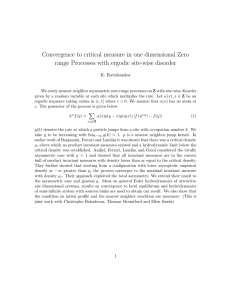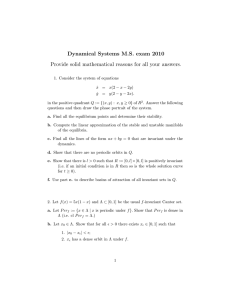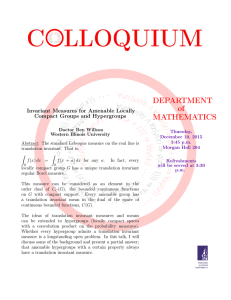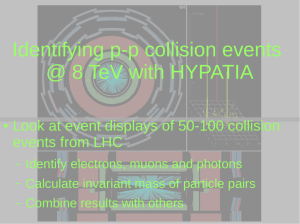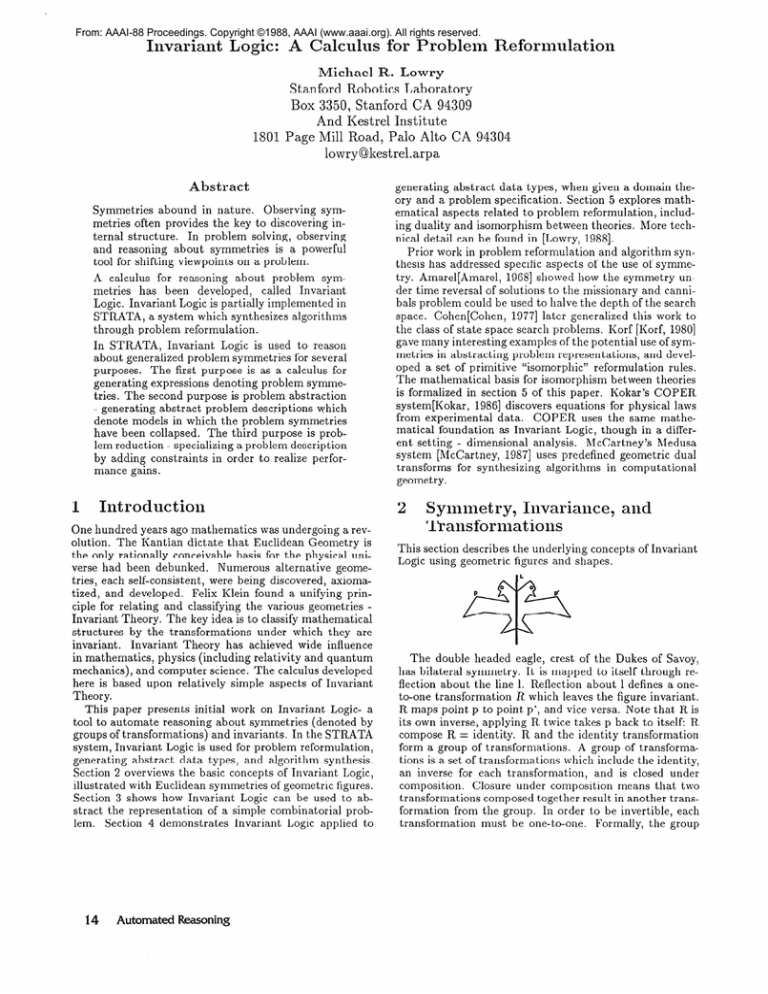
From: AAAI-88 Proceedings. Copyright ©1988, AAAI (www.aaai.org). All rights reserved.
Invariant
Logic:
A. Calculus
for Problem
Reformulation
Michael R. Lowry
Stanford Robotics Laboratory
Box 3350, Stanford CA 94309
And Kestrel Institute
1801 Page Mill Road, Palo Alto CA 94304
lowry@kestrel.arpa
Abstract
Symmetries
abound in nature.
Observing
symmetries often provides the key to discovering
internal structure.
In problem
solving,
observing
and reasoning
about
symmetries
is a powerful
tool for shifting viewpoints
on a problem.
A calculus
for reasoning
about
problem
symmetries
has been
developed,
called
Invariant
Logic. Invariant Logic is partially
implemented
in
STRATA,
a system which synthesizes
algorithms
through problem reformulation.
In STRATA,
Invariant
Logic is used to reason
about generalized
problem symmetries
for several
The first purpose
is as a calculus
for
purposes.
generating
expressions
denoting problem symmetries. The second purpose is problem abstraction
- generating
abstract
problem descriptions
which
denote models in which the problem symmetries
have been collapsed.
The third purpose is problem reduction - specializing
a problem description
by adding constraints
in order to realize performance gains.
1
Introduction
One hundred years ago mathematics
was undergoing
a revolution.
The Kantian
dictate that Euclidean
Geometry
is
the only rationally
conceivable
basis for the physical universe had been debunked.
Numerous
alternative
geometries, each self-consistent,
were being discovered,
axiomatized, and developed.
Felix Klein found a unifying
principle for relating
and classifying
the various geometries
Invariant Theory.
The key idea is to classify mathematical
structures
by the transformations
under which they are
invariant.
Invariant
Theory
has achieved wide influence
in mathematics,
physics (including
relativity
and quantum
mechanics),
and computer
science.
The calculus developed
here is based upon relatively
simple aspects
of Invariant
Theory.
This paper presents
initial work on Invariant
Logic- a
tool to automate
reasoning
about symmetries
(denoted by
groups of transformations)
and invariants.
In the STRATA
system, Invariant
Logic is used for problem reformulation,
generating
abstract
data types, and algorithm
synthesis.
Section 2 overviews the basic concepts of Invariant
Logic,
illustrated
with Euclidean
symmetries
of geometric figures.
Section
3 shows how Invariant
Logic can be used to abstract the representation
of a simple combinatorial
problem.
Section
4 demonstrates
Invariant
Logic applied to
14
Automated Reasoning
generating
abstract
data types, when given a domain theory and a problem specification.
Section 5 explores mathematical
aspects related to problem reformulation,
including duality and isomorphism
between theories.
More technical detail can be found in [Lowry, 19881.
Prior work in problem reformulation
and algorithm
synthesis has addressed specific aspects of the use of symmeuntry. Amarel[Amarel,
1968] s 1lowed how the symmetry
der time reversal of solutions
to the missionary
and cannibals problem could be used to halve the depth of the search
space.
Cohen[Cohen,
19771 later generalized
this work to
the class of state space search problems.
Korf [Korf, 19801
gave many interesting
examples of the potential
use of symmetries in abstracting
problem representations,
and developed a set of primitive
“isomorphic”
reformulation
rules.
The mathematical
basis for isomorphism
between theories
is formalized
in section 5 of this paper.
Kokar’s COPER
system[Kokar,
19861 d iscovers equations
for physical laws
from experimental
data.
COPER
uses the same mathematical foundation
as Invariant
Logic, though in a different setting - dimensional
analysis.
RlcCartney’s
hfedusa
geometric
dual
system [McCartney,
19871 uses predefined
transforms
for synthesizing
algorithms
in computational
geometry.
2
Symmetry, Invariance,
Transformat ions
This section describes
Logic using geometric
and
the underlying
concepts
figures and shapes.
of Invariant
The double headed eagle, crest of the Dukes of Savoy,
has bilateral
symmetry.
It is mapped to itself through reflection about the line 1. Reflection
about 1 defines a oneto-one transformation
&? which leaves the figure invariant.
R maps point p to point p’, and vice versa. Note that R is
its own inverse, applying R twice takes p back to itself: R
compose R = identity.
R and the identity
transformation
form a group of transformations.
A group of transformations is a set of transformations
which include the identity,
an inverse for each transformation,
and is closed under
composition.
Cl osure under composition
means that two
transformations
composed together result in another transformation
from the group.
In order to be invertible,
each
transformation
must be one-to-one.
Formally,
the group
elements
are the transformations,
composition
of transformations.
the
group
operation
is
s both rotational
The hexagram,
or Star of David,
and reflective symmetries.
It is invariant under the six rotations about its center (multiples
of 60 degrees) and six
axis of reflection.
In Invariant
Logic, this is denoted:
Invariant (hexagram,
Rot at ions Join Re f dect ions).
The
Join operation
takes two groups of transformations,
forms
the union, and then generates
the closure of this union under composition.
(An interesting
geometric
fact is that the
closure of the reflective
symmetries
includes the rotational
symmetries.)
The Meet operation
takes two groups of
transformations
and returns
their intersection.
The meet
of the rotational
symmetries
and the 3 reflective
symmetries with axis through
apexes of the hexagram
are the
rotations
of multiples
of 120 degrees.
This is because two
reflections
whose axis form an angle of n x 60 degrees generate a rotation
of n x 120 degrees.
The group of transformations
which leave a geometric
figure invariant
form a
lattice structure
with respect to its subgroups,
illustrated
below for the hexagram.
A subgroup is a subset of transformations which are closed under composition
and inverses.
Notice that as more subgroups
are joined together
they
converge upon the total group of transformations.
The
search space is commutative
and convergent.
In later sections of the paper problem specifications
will be abstracted
by discovering problem symmetries
and incorporating
these
symmetries
into the problem
formulation.
l3ecause
of
the commutative
and convergent
lattice structure
of the subgroups
of a group,
search control
is a
minor issue in problem
abstractiou
using Invariant
Logic.
Symmetry
Group
ions
n x 120
I
identity
The orbit of an object
under a transformation
group
is the equivalence
class of objects
to which it is transformed. It is an equivalence
class because a transformation
group includes the identity
(reflexivity),
inverses (symmetry), and is closed under composition
(transitivity).
The
metaphorical
origin of the term orbit is illustrated
by the
orbits of the triangles
in a hexagram
under rotations
of
multiples
of 120 degrees.
The black triangles
are mapped
to each other, as are the checkered triangles,
thereby forming two equivalence
classes of triangles
in the hexagram.
Each equivalence
class can be generated
by a representative element and the group of transformations.
Symmetry
can be used for simplifying
representations.
With bilateral
symmetry
only half a figure needs to be
given, along with the axis of reflective
symmetry.
The
hexagram,
considered
as a set of line segments,
can be
represented
by an isoceles triangle (one of the apexes), and
the transformation
group defined by the six rotations:
Hexagram
= Apply(Rotations,
triangle).
3
xtensioiial
Invariant
easoning
This section shows how Invariant
Logic can be applied to
problem abstraction
when the semantics
are given extensionally,
i.e.
as an explicit
listing of a set.
The classic
missionary
and cannibals
problem
[Amarel,
19681, is to
move 6 people across a river in a 2 man boat without any
of them eating each other. hiost accounts
of this problem
begin with the formulation
that there are 3 missionaries
and 3 cannibals,
and a legal intermediate
state is one in
which the missionaries
are never outnumbered
and then
eaten on either side of the river.
However this is already
an abstract
formulation
which incorporates
a great deal of
relevant
information
about the legal states.
An observer
would not see this formulation,
instead he would see distriHe
butions of specific people on the left and right banks.
would probably
begin to notice patterns,
especially
nearly
identical
intermediate
states which only differed by interchanging specific people.
Just like the triangles of a hexagram
described orbits under rotations
of multiples
of 120 degrees, so do the intermediate states describe
orbits under the transformations
defined by interchanging
specific people. Assume the people are Mike,Max,Cal,Cindy,Cory,
and that our observer
notes that Mike,Mary,Max
are mutually
interchangeable,
as are Cal, Cindy, Cory. He also notes that the left and
right banks can be switched.
On this basis he is able to
partition
the 34 legal states
he observes
into five orbits.
Representative
states in the five orbits are given below (the
river is represented
by
!!):
nobody
Cal Cindy
Cal Cindy
Cal Mary
Cal
Cory
!! Cal Cindy Cory Mary Max Mike
!! Cory Mary Max Mike
!! Mary Max Mike
!! Cindy Cory Max Mike
!! Cindy Cory Mary Max Mike
These five representative
states contain sufficient
information to generate the complete
set of 34 states given the
transformation
group which arises from the possible
interchanges
among people and banks.
Note that each of
these representative
states are the smallest
representative
in their orbits with respect
to lexicographic
ordering
on
names.
Except
for the fourth state,
they are all lexicographically
ordered.
This is the basic idea for problem
reduction through transformations
- choosing a representation which satisfies additional
constraints,
such as ordered.
A constraiut
cau be added to a problem
description if some representative
of each orbit satisfies
the additional
constraint.
This is especially
useful for
algorithm
synthesis,
because a more efficient algorithm
can
often be synthesized
when additional
constraints
can be assumed in an input-output
specification.
While problem
reduction
chooses a representative
for
each orbit, problem abstraction
generates
an abstract
description
in terms of invariant
properties
for each orbit.
Lowry
15
Invariance
under a transformation
group is a filter to determine which properties
are relevant
to an abstract
description.
The value of an invariant
property
is shared by
A set of invariant
properties
every element
in an orbit.
is complete
if they uniquely
determine
an orbit from the
abstract
values and the transformation
group.
As an example,
let X be a set, P be the powerset
of
X, and R be a subset of P. Thus R is a set of subsets of
X. Let AZZPi(X)
d enote the group of all possible
premutations of the elements
in X. A permutation
is a one-toone mapping of the elements
in a finite set to themselves.
It can be thought
of as a reordering
of a sequence.
If
Invariant(
R, AZZPi(X)),
th is means that the size of the
subsets in R is a complete
set of invariants.
Proof:
Let
rl be an element of R, e.g. a subset of X, whose size is
nl. Then for any other r2, subset of X with size nl, there
is a one-to-one
transformation
from the elements of rl to
the elements
of r2.
This transformation
is contained
in
AZZPi(X).
For any subset of X, si, whose size is not nl,
there is no one-to-one
transformation
from rl to si. Thus
the orbit of rl contains all subsets of equal size from X and
only the subsets of equal size. QED,
The following partial set of rules abstract
set-theoretic
types in terms of invariant
properties.
Proofs similar to
the one above can be found in [Lowry, 19881. In the rules,
MS is some mathematical
structure
which is being abstracted.
In the missionary
and cannibals
example,
MS
is the set of legal intermediate
states.
MS is invariant
where X is some set used in MS.
R
under AZZPi(X),
is a subtype
of MS.
The type declarations
are based on
the REFINETn’
language.
Map(domain,
range) is the
declaration
for a partial function
from domain to range.
is the declaration
for a set with elements
Set(domain)
from domain.
TupZe(domainl...domainN)
is the declaration for an ordered tuple with successive
elements from
domainl,
domain2,
etc. The abstraction
of both the subtype and the extension
are given.
1. The invariant
of a subset of X is its size:
R : set(X)
AND
Invariant(MS,AZlPi(X))
3 R : integer
The extension
is the size of the subset.
2. The proof given above, and embedding
rule 1.
R : set(set(X))
AND
Invariant(MS,
AZZPi(X))
+ R : set(integer)
The extension
is a set of integers,
representing
the size of
the subsets in R.
3. If the value of a multi-argument
function
is independent of one of its arguments,
then delete the argument.
R : map(tupZe(..X..),
range)
AND Invariant(MS,
AlZPi(X))
+ R : map(tupZe(....),
range)
Extension:
project
out the argument
whose domain is X.
4. A similar rule for a relation.
R : set(tupZe(..X..))
AND
Invariant(h4S,
AZZPi(X))
=+ R : set(tupZe(....))
Extension:
project
out the argument
whose domain is X.
5. A function from domain to range can be transformed
to a function
from range to subsets
of domain - i.e. the
domain elements which map to a given range element.
The
invariant
in this rule is the number of domain elements
which map to a range element.
R : map(X, range) AND
Invariant(MS,
AZlPi(X))
16
Automated Reasoning
+ R : map(range,
integer)
Alternatively
j R : bag(range)
Extension:
the range is mapped to the number of elements
in the inverseimage.
6. Every function
defines an equivalence
relation on its
domain - the elements
which map to the same range element. This partitioning
of the domain is the invariant
in
this rule.
R : map(Domain,
X) AND Invariant(MS,
AZZPi(X))
+ R : partition(Domain)
Extension:
the domain is partitioned.
When X is only a subset of the domain or range Y the
following rules apply, where D is the set difference between
Y and X. The extensions
and subtypes
are analogous to the
previous rules, but involve tupling to separate
X and D.
7. R : set(Y)
AND
Invariant(MS,
AZZPi(X))
+ R : tupZe(integer,
set(D))
8. R : map(Y, range) AND
Invariant(MS,
AllPi(
+ R : map(range,tupZe(integer,
set(D)))
9. R : map(Domain,
Y)
AND
Invariant(MS,AZZPi(X))
r~
R : tupZe(partition(Subdomainl),
map(Subdomain2,D))
Subdomainl
is the elements
of Domain which map to X,
and Subdomain
is those which don’t map to X.
These rules can be applied to obtain
an abstract
representation
for the set of legal intermediate
states in the
missionary
and cannibals
problem.
These rules are not
strictly
compositional
on subtypes,
technical
details can
be found in [Lowry, 19881. Each state is a mapping from
people to locations,
so the set of legal states has the following type:
set(map({Mibe,
Mary, Max, Cindy, Cal, Cory},
{left, right}))
The transformation
group which leaves the 34 legal
states invariant
is defined usiug the AZZPi(X)
construction:
AllPi(Mike,
Mary, Max)
Join AllPi(CaZ,
Gory, Cindy)
Join AlZPi(le ft, right).
This
transformation
group is
composed
of three subgroups
which are joined together.
These subgroups
will be used in successive
rules to abstract the representation.
Rule 8 uses AZZPi( Mike, Mary, Max)
to obtain the abstracted
type:
set(map({Zeft,
right}, tupZe(integer,set(CaZ,
Gory, Cindy))))
Rule 1 then uses AZZPi(CaZ, Gory, Cindy) to obtain:
set(map({Zeft,
right), tupZe(integer,integer)))
Finally Rule 5 uses AZZPi(Zeft, right) to obtain:
set(bag(tupZe(integer,
integer)))
The extension
for this abstract
type is given below, with
the corresponding
representative
state from each orbit.
bag((0,0),(3,3)) nobody
bag((0,2),(3,1))
bag((0,3),(3,0))
bag((1,1),(2,2))
bag((0,1),(3,2))
4
!! Cal Cindy Cory Mary Max
Cal Cindy !! Cory Mary Max Mike
Cal Cindy Cory
!!
Mary Max Mike
Cal Mary
!! Cindy Cory Max Mike
!! Cindy Cory Mary Max Mike
Cal
Intensional
Invariant
Mike
Reasoning
This section describes
how STRATA
uses Invariant
Logic
for abstracting
a problem
when the semantics
are given
intensionally,
i.e. as a theory.
First the rules for computing symmetries
for composite
relations
are given.
Then
a simple problem
is introduced,
and it is shown how the
Knuth-Bendix
completion
algorithm
can be used to calculate additional
problem
symmetries.
A special type of
symmetry
- congruences
- are described.
The application
of Invariant
Logic to the abstraction
process is shown, and
the alternative
of specialization
through problem reduction
is described.
The following
rules of invariant
logic provide a calculus for determining
the invariants
of a composite
relation
based on the invariants
of its subparts.
The primary observation
for boolean
operations
on relations
is that the
result is invariant under the intersection
(meet) of transformation groups for the separate
arguments.
This supports
on composite
rela
“greatest
common
divisor” reasoning
tions. In the rules which follow, R is a relation
i.e. type
domainN),
tuple(domainl,domain2....
and TG is a transformation
group over the tuples.
These rules are slightly
simplified versions of ones in [Lowry, 19881, which address
some technical
issues concerning
whether the domains are
distinct.
If a relation
is invariant,
then so is its complement:
Invariant (R, TG) z Invariant(lR,
TG)
Boolean operations
such as union and intersection
preserve invariance
with respect to the meet of transformation
groups (Rl,R2
are sets of tuples of the same type):
Invariant(Rl,TGl)
AND
Invariant(R2,
TG2)
meet TG2))
+ Invariant(R1
boolop R2, (TGl
The Cartesian product over relations preserves invariance
under the direct product of transformation
groups.
Invariant(Rl,TGl)
AND
Invariant(R2,TG2)
+ Invariant (Rl @ R2, TGl @ TG2)
IF a relation
is invariant
under a transformation
group,
then it is invariant
under any of its subgroups:
Invariant(R,TG)
AND Subgroup(TGl,TG)
+ Invariant (R, TGl)
Consider the problem
of common-members:
given two
lists as input, output
a list whose elements
are the common members
of the two lists.
Abstractly,
this problem
The problem
can be specialis simply set-intersection.
ized by problem
reduction
to assume the two input lists
are ordered,
an efficient
algorithm
is to march down the
two ordered lists in tandem.
The reduction
is achieved by
sorting the two input lists, which is a transformation
which
leaves the problem invariant.
STRATA
generates
abstract
problem
descriptions
from
a concrete problem description
and a domaiu theory. The
conceptual
foundation
is partially
described
in [Lowry,
19871, this section discusses interesting
aspects of the implementation
not covered earlier.
For common-member,
the domain theory is that of lists; the following equational
theory is given to STRATA,
where variables
are denoted
theories
are often used for specifying
by & . Equational
The equations
can be turned into a
abstract
data types.
logic program by making one side of each equation into the
left hand side of a rewrite rule, and the other side into the
right hand side. Equality
between ground terms can be decided by rewriting
them to normal form with the derived
rewrite rules.
(append nil &l3) = &I3
(append(cons
&a &I)&l3)=(cons
(member &x nil) = false
(member &x (cons &y nil)) =
&a
(EQ
(append
&x
&y)
&I
&13))
(member
&x (append &Ll
&l2))
= (member
&x &Ll)
OR (member &x &L2)
;; equations
defining semantics of AND, OR, IFF
(common-member
&Ll
&L2 &L3) =
(member
&x &L3)
IFF
(member
&x &Ll)
AND (member
&x &L2)
symmetries.
the problem
The first step is to generate
of relations
deduces that
The rule for boolean composition
the symmetries
of member
are a subset
of the symmetries of common-member.
The symmetries
of member are
not known, and the compositional
calculus does not apply
(the rules above don’t handle recursive
definitions).
The
homomorphism
method
described
in [Lowry, 19871 finds
the symmetries
of member; it is implemented
by applying
the Knuth-Bendix
completion
algorithm.
The basic idea
in setting up the Knuth-Bendix
algorithm
is to make two
copies of the problem name, and linking them.
One copy
has a heavier weight than any other symbol (e.g. member).
The other copy has a lighter weight than any other symbol
(e.g. member’).
Intuitively,
the K-B algorithm
percolates
the problem definition
through
the domain theory to the
lighter weight problem name, generating
problem symmetries.
**Derived
from K-6 when member defined with
(member’ &x (append &y &z))
=
(member’ &x (append
&z &y))
(member’ &x (append &y &y))
=
(member’ &x &y)
**Derived
from K-B when member defined with
(member’ &x (cons &a (cons &b &L)))
=
(member’ &x (cons &b (cons &a &L)))
(member’ &x (cons &a (cons &a&L)))
=
(member’ &x (cons &a &L))
append**
cons**
These
derived theorems
denote the symmetry
of lists
under transformations
of reordering
and deleting repeated
elements.
Structural Induction is used to verify that new
equations
can be extracted
from these theorems.
An equation represents
a special kind of problem symmetry
(a congruence),
which, when substituted
into itself still denotes
a problem symmetry.
As part of the structural
induction
proof for the commutativity
of append,
STRATA
generates and proves the following theorem:
(member’ &x (append (append
&x &y) &z)) =
(member’ &x (append (append
&y &x) &z))
After proving structural
induction,
STRATA
extracts
the following axioms and adds them to the theory of lists,
thereby deriving the abstract
data type for sets. The added
axioms for append make it commutative
and idempotent,
thus the semantics
are set-union,
and append becomes
set-union
(names don’t matter
for the denotation
of a
theory) :
Invariant(common-members,
(append’ &y &z) = (append’ &z &y))
Justifies add-axiom((append’
&y &z)=(append’
&z &y))
Invariant(common-members,(append’
&x &x) = &x)
Justifies add-axiom((append’
&x &x) = &x)
An alternative
to abstraction
is problem
reduction
adding constraints
which can be achieved with the transformations
which leave the problem invariant.
In contrast
to abstraction,
there are many possible problem reductions
Lowly
17
because there are many possible representative
elements in
each orbit. One source of constraints
are derived preconditions for operators.
In this example, if the lists are ordered
an inexpensive
necessary
condition
on membership
is that
the first element
of the list is less than or equal to the
element being tested for membership.
This gives rise to
the derived precondition
that the input lists are ordered,
which can be achieved
by repeatedly
switching
adjacent
list elements
which are out of order (bubble
sort).
This
switching
transformation
is denoted by one of the derived
equations
for cons:
(cons &a(cons
&b &L))=(cons
&b (cons &a &L))
See [Lowry, 19881 for the application
of problem reduction
to synthesizing
Karmarkar’s
linear optimization
algorithm.
5
Duality and Isomorphic
Theories
Duality can be expressed
as a symmetry
among the symbols of a theory which leave the true sentences
invariant.
A transformation
from symbols to symbols is a representation map, designated
RMap.
Duality has bilateral
symmetry, an example is boolean algebra (Not is self dual):
And +-+ Or
true t---+ false
Not c--f Not
This representation
map transforms
true sentences
to true
sentences:
(z And true) = x t----f (x Or false)
= x
Duality
of a theory
is easy to verify - simply
transform the
axioms
with
the representation
map,
and
prove the transformed
axioms using the original
theory:
Dual(Theory,
RMap)
G Axioms
I- RMap(Axioms)
Because proofs are invariant
under renaming
of symbols,
we
obtain for free the dual proofs by applying the represents
tion map, which is its own inverse:
RMap( Axioms)
i- Rmap( Rmap( Axioms))
= Axioms
Duality
is often exploited
in algorithms.
Mini-max
search and alpha-beta
pruning
use duality
to efficiently
search the space of look ahead moves in a competitive
game. Linear optimization
problems,
particularly
the special class of network flow problems,
can be efficiently solved
by primal-dual
algorithms.
In geometric
algorithms,
the
duality between lines and points in 2-D projective
geometry can be used to expand theuses of subroutines.
For
example, collinearity
of points can be mapped to intersection of lines.
In duality,
the representation
map is from symbol to
symbol.
Isomorphic
theories
are defined by generalizing
the representation
map from symbols
to terms. A representation
map from symbols to terms is not invertible,
so
the definition is more complex.
Theory A and theory B are
isomorphic
iff there exists representation
maps Rl from A
to B and R2 from B to A which satisfy:
1. Axioms(B)
I- Rl(Axioms(A))
2. Axioms(A)
t- R2(Axioms(B))
3. Rl o R2 = Identity(A)
4. R2 o Rl = Identity(B)
Boolean
with primitives
18
Nand,true,
algebra
false is isomorphic
Automated Reasoning
defined
to boolean
algebra defined with primitives
And, Or, Not, true, f alse.
The representation
maps Rl, R2 are given below:
Or(x, y) -+ Nand(Nand(x),
Nand(y))
And(x, y) -+ Nand(Nand(x,
y))
Not(x)
---f Nand(x)
Not(And(x,
y)) - Nand(x, y)
The last two conditions
on isomorphism
between theories is that the composition
of representation
maps yields
the identity.
This entails that an equivalence
be proven,
for Nand the composition
of representation
maps yield:
y))
Nand(x,
y) + Not(And(x,
--) Nand(Nand(Nand(x,
y))) The following
equivalence
has to be proved in order to show that Rl o R2 is the
identity:
Nand(x, y) = Nand(Nand(Nand(x,
y))).
Similar equivalences
are needed for And, Or, Not.
An alternative
definition
of isomorphism
between theories is that each can be conservatively
extended
with defined relations
and functions
to include the other. Isomorphism between theories is one way to define reformulation.
6
Acknowledgements
This paper benefitted
from the technical
and editing help
provided by Tom Binford,
Leonid Frants, Joseph Goguen,
Walter Bill, Douglas Smith, George Stolfi, and Yinyu Ye.
Special thanks go to the reviewers,
who made substantial
comments
on clarifying
the paper.
This work was supported in part by DARPA
sub-contract
AIADS-S10935-1
and ONR contract
N00014-87-K-0550.
The views and conclusions in this paper are solely those of the author.
References
[Amarel, 19681 Saul Amarel.
On representations
of probMachine Intelligence
lems of reasoning about actions.
3, 1968.
[Cohen, 19771 Brian
certain problem
1977.
Cohen.
The mechanical
discovery
properties.
Artificial Intelligence,
of
8,
hI. Kokar . Determining
[Kokar, 19861 h4 ieczslaw
arguments of invariant
functional
descriptions.
Machine
Learning, 1, 1986.
[Korf,
19801 Richard
E. Korf. Towards a model of repreArtificial Intelligence,
14(l),
April
sentation
change.
1980.
[Lowry, 19871 Michael
R.
Lowry.
The
abstraction/implementation
model of problem reformulation.
In IJCAI-87,
August 1987.
[Lowry, 19881 Michael
R. Lowry.
through Problem
Reformulation.
ford University,
1988.
Algorithm
Synthesis
PhD thesis,
Stan-
[McCartney,
19871 Robert D. McCartney.
Synthesizing
algorithms
with performance
constraints.
In AAAI-87,
1987.



